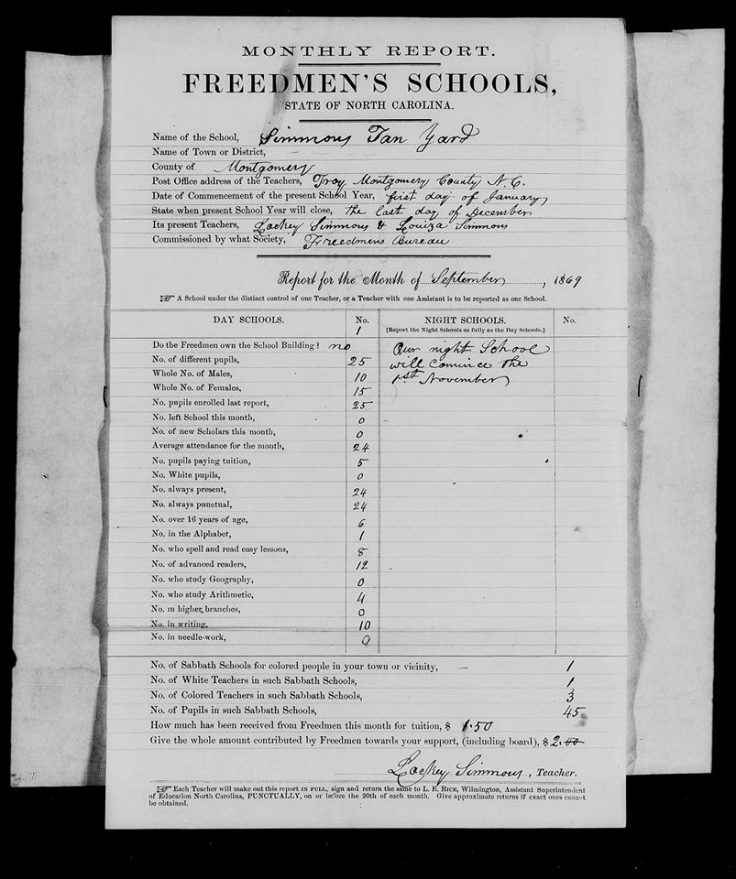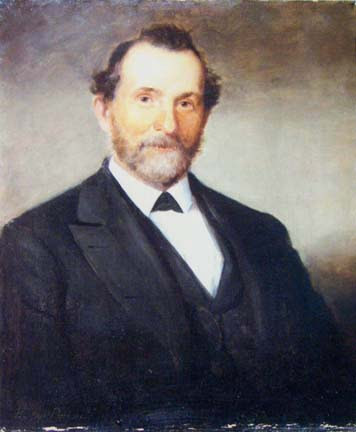Lockey Simmons (1796-1880), my great great great grandfather, taught his freed slaves to read and write, as part of the Freedmen’s Schools movement throughout the South during Reconstruction. He ran a very profitable tannery and leather business in Montgomery County, NC (near Troy), acquired a lot of land in the area, and about 40 slaves (read their stories here). The slaves helped farm the land. Because of his passion for educating slaves, his white contemporaries called him “a fool for education.” That was not meant as a compliment. Some labeled him a troublemaker. Teaching slaves and newly freed blacks to read was illegal in some places. He was also on the board that founded Wake Forest College. Here’s part of his story.


— I discovered this on the Montgomery County, NC Facebook group, posted by Garret Maynard of Star, NC. I’ve added annotations based on what I know:
“Little is known of Lockey Simmon’s early life. [Much is known of his family ancestry going back to the Netherlands and the Pilgrims. See this.] He was born in Montgomery County, N.C. on April 14, 1796, a son of Benjamin Simmons and Annie Alexander Simmons. He was married to Mary L. Pennington on December 21, 1826. [Mary died very young, leaving Lockey with six children to raise.]
“A brother of Pleasant Simmons of the Little River community [Lockey’s genealogical records do not indicate that he had a brother named “Pleasant”], the brothers had large land holdings throughout the county. He was for many years county surveyor and surveyed both the towns of Lawrenceville and Troy.
“His plantation was near Troy and carried the name of Simmon’s Tan Yard, for he operated a large hide-tanning and shoe shop operation there. In fact, the ford across Little River on the way to the plantation carried the name of “Simmons Ford.”
“(There was no bridge between Biscoe and Troy in those days!)
“In 1833, at the Baptist Convention held at the Cartledge Creek Church in Richmond County of which Lockey Simmons was a delegate, it was decided that North Carolina needed a Baptist institution of higher learning. Thus was born the Wake Forest Manual Labor Institute. Lockey Simmons was on the early boards of trustees for this college and was a strong supporter for the rest of his life.
“The school was designed to teach ministers and lay ministers. It was founded on the old Jones Plantation, 600 acres north of Raleigh in the dense forests of Wake County.
“Lockey’s son, William Gaston Simmons (1830-1889), enrolled in the class of 1851.
“The name of the school was later changed to Wake Forest College.
William Gaston Simmons’ Conversion
“Reverend Frank Jordan recalled that: “The conversion of Professor Simmons was rather remarkable. One night during the meeting, after the service had closed in the Chapel, about ten o’clock in the night, I heard someone coming down the passage and knock at my door, when; In came Simmons, as happy a man, I think, as ever I saw. As he and I were from the same county and had always been great friends, it seemed that he wanted to see me first. So he took me in his arms and blessed and praised God for His redeeming grace and dying love. One after another came into my room until it was full. At his request, I went to Professor White. He came, and it was a time of great rejoicing. Simmons finally lay down flat on the floor and blessed and praised the Lord. I think it was 1 o’clock before we dispersed and retired.
“I never saw anyone who seemed to have brighter manifestations of his acceptance with God. And oh, what a great man he made, in almost every sense of the word. He was one of the ripest scholars of his age, could teach any class in college, in whatever department, and was about the only man that could.
“He told me that he had read every book in the library of the Philomathesian Hall and that he never saw a problem in mathematics that he could not solve. And further, he told me that when he worked on the farm before he went to college, he would take his arithmetic to the field, fasten it on his plow stock, and solve problems as he would follow his plow. He graduated with first distinction, and was first elected tutor and then professor, which office he filled with great ability to the time of his death.
“He married Miss Mollie Foote (Mary Elizabeth Foote, 1833-1917) of Warren County, a refined and accomplished lady, by whom they raised a family of remarkably intelligent children. They now have two sons who are professors in college. I was at their wedding at his father’s, Lockey Simmons, in Montgomery County.”
“During the Civil War, it was because of Dr. William Gaston Simmons and Lockey Simmons that Wake Forest stayed open. Lockey’s granddaughter recalled in the 1930s that: “Shoes were quite scarce in those days, and I do not remember having a pair of ‘store- bought’ shoes or stockings until I was quite a large girl. My mother and grandmother knit all of our stockings for a number of years after the slaves were freed. My grandfather Simmons had a shoe shop on his plantation near Troy, N.C. and kept us supplied with shoes.”
“Tanning leather and shoe manufacturing in those days required salt, which was greatly scarce, nay; non-existent in the Confederate states at the time, but that is another story for another time…
“Perhaps Lockey Simmons’ greatest and noblest deeds were conducted during the sunset years of his life. After the Civil War was over, and the slaves were given their freedom, he took it upon himself to give the freedmen an education:
“Name of the School – Simmons’ Tan Yard School. The Bureau of Refugees, Freedmen, and Abandoned Lands, more popularly known as the ‘Freedmen’s Bureau’, paid Mr. Simmons $10 rent on a building at his plantation for use as a school for the former slaves, and Mr. Simmons acted as teacher.
“The South was under the watchful eye of the United States government in those reconstruction days, and Lockey Simmons spent his last days giving instruction in the alphabet, arithmetic, and writing to those people who he had formerly called his own property. Regarding their help, before President Andrew Johnson pardoned and returned all of the Southern States to the Union, the Freedmen’s Bureau asked:
“How long will Northern charitable aid be needed for Freedmen and Refugee Schools in your district?”
Old man Simmons simply confessed: “Until the proper civil authorities take charge of them.”
Another question posed: “What is the public sentiment as to the education of Freedmen and Poor White? : Very Unfavorable.”
“Lockey Simmons died January 23, 1880, but the work that he labored over so lovingly for all people should be remembered. In fact, the work that the former slave owners did to educate the former slaves would come to be torn down in the 1890’s with the introduction of the Jim Crow Laws.
“It would be nearly another century before the Civil Rights Movement would begin to dispel the old thoughts of the designing politicians … and we are still fighting to dispel them to this day! Happy Monday dear friends!”
Related:
- 1880: Surviving Family Photograph and Memoir Reveal Life During and After Civil War in NC
- Founding of Wake Forest: Wake Forest Historical Museum. This article leaves out essential details about the Simmons.

Wonderful!